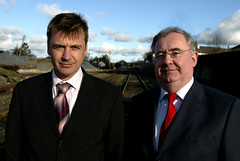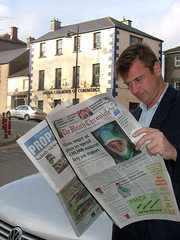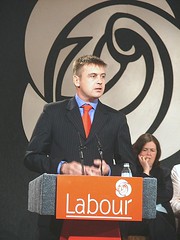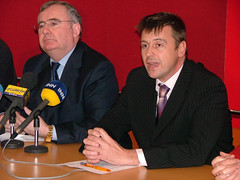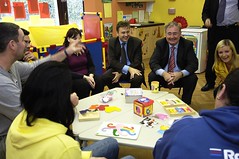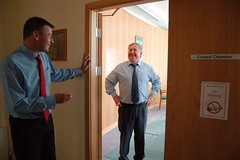Tuesday, August 12, 2008
Chingeltei District Health Unit
I reported for duty at the HQ of Chingeltei District Health Unit (CDHU) this morning. The first person I was introduced to was Jill, my interpreter, who is going to translate for me for the next three weeks. Jill is a General Surgeon by training and spent a few years in Auckland, New Zealand, before returning to Ulanbataar (UB).
We met with the Director of the CHDU and her staff and had a one-hour question and answer session about the District and about what they hoped that I could help with over the coming few weeks. They also gave me an overview of the area they work in.
UB is split up into 9 Duuregs. Each has their own local government structure. I have been assigned to the Chingeltei district. It's population is about 160,000 (about the size of Meath) and it stretches from the city centre right out to the hills surrounding the capital. There are 18 sub-districts, or Khoroos, different in character and ranging from city businesses to Ger encampments.
CHDU has 18 family General Practices (like local GPS), one for each Khoroo. Each deals with between 3,000 and 10,000 people. Usually these have between 4-6 doctors and 4-6 nurses. There are NO administrative staff. All reception work and filing is done by the doctors and nurses themselves.
There are also two ambulatory buildings (assessment, consultation, dental services, outpatients) two polyclinics and one General hospital.
The Director then took me to meet some key people in other institutions. The first was the Chairperson of Chingeltei Representatives - she was elected by the 35 local area representatives. She outlined her hopes for an improved heath service, and believes that new equipment for the area is essential.
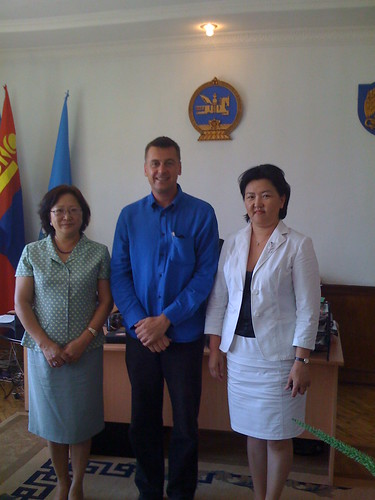
Meeting the Director of Chingeltei District Health Unit and the Chairperson of the Chingeltei Council
I also met with the Deputy Governor of the district and with the Director of the City Health Unit. Each provided me with an overview of how their organisation fits into the overall health system. I will be working with these bodies over the next few weeks and they all expressed their willingness to help out on the project.
We went to see some of the CHDU premises after lunch. I went to two GP practices - one old and one new. The facilities were quite basic compared to western standards and the quality of construction left room for improvement. Both of the GP practices served the Ger districts on the outskirts of the capital.

Ger District on the outskirts of Ulanbataar
I also visited the two Ambulatory premises. Both were in need of serious refurbishment. Coupled with that, the equipment looked like it has been there for a very long time.
After work I headed over to a dinner with other VSO volunteers. At this time of the year many volunteers are finishing their placement. As a result there are a lot of "farewell parties". Also, their replacements are now arriving. So it's a constant flow of people out of and in to the volunteer network.
The volunteers come from all walks of life and from right around the world. I've met people from Australia, New Zealand, America, Europe, Africa and Asia. The ages range from early 20's to early '70s (the cut-off age is 75, but I believe that this is being re-considered). So, one is never too young or old to become involved!
We met with the Director of the CHDU and her staff and had a one-hour question and answer session about the District and about what they hoped that I could help with over the coming few weeks. They also gave me an overview of the area they work in.
UB is split up into 9 Duuregs. Each has their own local government structure. I have been assigned to the Chingeltei district. It's population is about 160,000 (about the size of Meath) and it stretches from the city centre right out to the hills surrounding the capital. There are 18 sub-districts, or Khoroos, different in character and ranging from city businesses to Ger encampments.
CHDU has 18 family General Practices (like local GPS), one for each Khoroo. Each deals with between 3,000 and 10,000 people. Usually these have between 4-6 doctors and 4-6 nurses. There are NO administrative staff. All reception work and filing is done by the doctors and nurses themselves.
There are also two ambulatory buildings (assessment, consultation, dental services, outpatients) two polyclinics and one General hospital.
The Director then took me to meet some key people in other institutions. The first was the Chairperson of Chingeltei Representatives - she was elected by the 35 local area representatives. She outlined her hopes for an improved heath service, and believes that new equipment for the area is essential.

Meeting the Director of Chingeltei District Health Unit and the Chairperson of the Chingeltei Council
I also met with the Deputy Governor of the district and with the Director of the City Health Unit. Each provided me with an overview of how their organisation fits into the overall health system. I will be working with these bodies over the next few weeks and they all expressed their willingness to help out on the project.
We went to see some of the CHDU premises after lunch. I went to two GP practices - one old and one new. The facilities were quite basic compared to western standards and the quality of construction left room for improvement. Both of the GP practices served the Ger districts on the outskirts of the capital.

Ger District on the outskirts of Ulanbataar
I also visited the two Ambulatory premises. Both were in need of serious refurbishment. Coupled with that, the equipment looked like it has been there for a very long time.
After work I headed over to a dinner with other VSO volunteers. At this time of the year many volunteers are finishing their placement. As a result there are a lot of "farewell parties". Also, their replacements are now arriving. So it's a constant flow of people out of and in to the volunteer network.
The volunteers come from all walks of life and from right around the world. I've met people from Australia, New Zealand, America, Europe, Africa and Asia. The ages range from early 20's to early '70s (the cut-off age is 75, but I believe that this is being re-considered). So, one is never too young or old to become involved!

